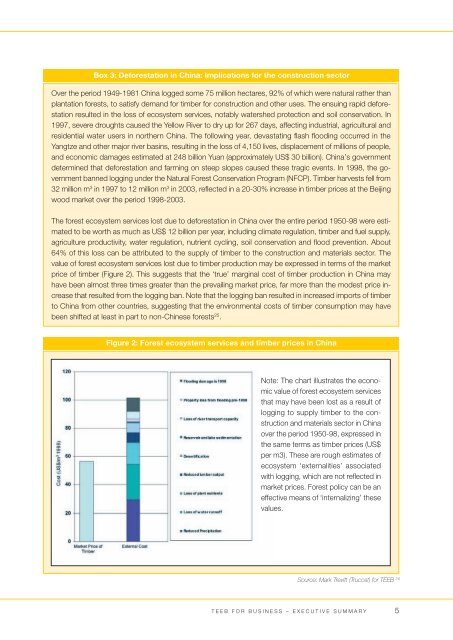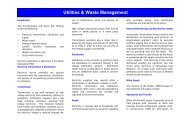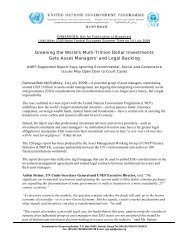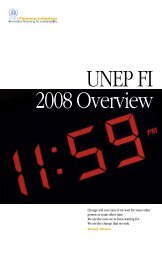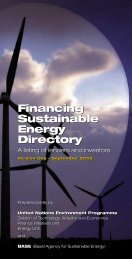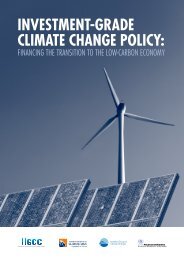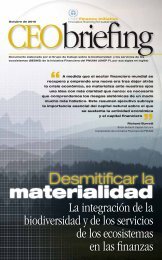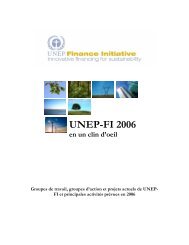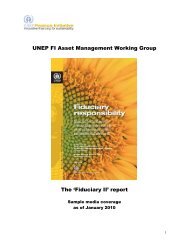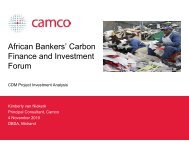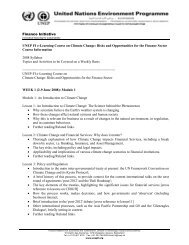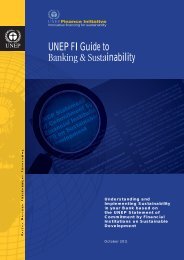for Business - TEEB
for Business - TEEB
for Business - TEEB
Create successful ePaper yourself
Turn your PDF publications into a flip-book with our unique Google optimized e-Paper software.
Box 3: De<strong>for</strong>estation in China: Implications <strong>for</strong> the construction sector<br />
Over the period 1949-1981 China logged some 75 million hectares, 92% of which were natural rather than<br />
plantation <strong>for</strong>ests, to satisfy demand <strong>for</strong> timber <strong>for</strong> construction and other uses. The ensuing rapid de<strong>for</strong>estation<br />
resulted in the loss of ecosystem services, notably watershed protection and soil conservation. In<br />
1997, severe droughts caused the Yellow River to dry up <strong>for</strong> 267 days, affecting industrial, agricultural and<br />
residential water users in northern China. The following year, devastating flash flooding occurred in the<br />
Yangtze and other major river basins, resulting in the loss of 4,150 lives, displacement of millions of people,<br />
and economic damages estimated at 248 billion Yuan (approximately US$ 30 billion). China’s government<br />
determined that de<strong>for</strong>estation and farming on steep slopes caused these tragic events. In 1998, the government<br />
banned logging under the Natural Forest Conservation Program (NFCP). Timber harvests fell from<br />
32 million m 3 in 1997 to 12 million m 3 in 2003, reflected in a 20-30% increase in timber prices at the Beijing<br />
wood market over the period 1998-2003.<br />
The <strong>for</strong>est ecosystem services lost due to de<strong>for</strong>estation in China over the entire period 1950-98 were estimated<br />
to be worth as much as US$ 12 billion per year, including climate regulation, timber and fuel supply,<br />
agriculture productivity, water regulation, nutrient cycling, soil conservation and flood prevention. About<br />
64% of this loss can be attributed to the supply of timber to the construction and materials sector. The<br />
value of <strong>for</strong>est ecosystem services lost due to timber production may be expressed in terms of the market<br />
price of timber (Figure 2). This suggests that the ‘true’ marginal cost of timber production in China may<br />
have been almost three times greater than the prevailing market price, far more than the modest price increase<br />
that resulted from the logging ban. Note that the logging ban resulted in increased imports of timber<br />
to China from other countries, suggesting that the environmental costs of timber consumption may have<br />
been shifted at least in part to non-Chinese <strong>for</strong>ests 25 .<br />
Figure 2: Forest ecosystem services and timber prices in China<br />
Note: The chart illustrates the economic<br />
value of <strong>for</strong>est ecosystem services<br />
that may have been lost as a result of<br />
logging to supply timber to the construction<br />
and materials sector in China<br />
over the period 1950-98, expressed in<br />
the same terms as timber prices (US$<br />
per m3). These are rough estimates of<br />
ecosystem ‘externalities’ associated<br />
with logging, which are not reflected in<br />
market prices. Forest policy can be an<br />
effective means of ‘internalizing’ these<br />
values.<br />
Source: Mark Trevitt (Trucost) <strong>for</strong> <strong>TEEB</strong> 26<br />
T E E B F O R B U S I N E S S – E X E C U T I V E S U M M A R Y 5


